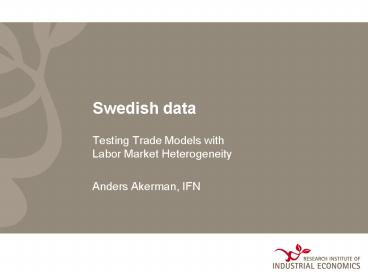Swedish data PowerPoint PPT Presentation
1 / 17
Title: Swedish data
1
Swedish data
- Testing Trade Models with Labor Market
Heterogeneity - Anders Akerman, IFN
2
Introduction
- Good supply of firm, plant and individual level
microdata - Generally supplied by Statistics Sweden
- MONA (Microdata Online Access)
- FIEF
- Database on Swedish MNEs collected by IFN
3
The Swedish context (1)
- A different setting than when using US data
- Very open economy
Source World Development Indicators.
4
The Swedish context (2)
- Large government sector
Source World Development Indicators.
5
The Swedish context (3)
- High FDI inflows
Source World Development Indicators.
6
The Swedish context (4)
- High FDI outflows
Source World Development Indicators.
7
Overview
Individuals Examples Education, employment
history, gender, age, wages, job tasks
Firms Examples Capital, number of employees,
trade pattern, intermediates, RD, value added
Plants Examples Employment and wage according
to age, education and gender
Matched firm-worker data
Multinationals Sales and employment by foreign
affiliates of Swedish MNEs
8
Firm level data
- Företagsdatabasen / Firm level database
- lt 1996 Selection subject to size cutoff
- 1996 All firms covered
- Includes much information on all firms
- 1. Trade (import and exports with information on
within/between firm trade, product,
origin/destination country, value, weight,
industry classification) - 2. Production (inputs such as labour, capital,
energy, raw materials, profits, RD, value added) - 3. Other age, geography, foreign ownership
(changes) - About 300,000 firms since 1996.
9
Plant level employment data
- Arbetställedatabasen (RAMS) / Plant level
database - Selection criteria similar as firm level data,
but complete coverage already from 1986
(compatible identification system) - Geography, industry
- Employee characteristics wages and employment
according to skill level, age and gender etc.
(based on November employment) - About 400,000 plants since 1986.
10
Individual data (1)
- Lönedatabasen / Employment database (compatible
with previous datasets) - Years 1970 2005. Covers all employments in the
public sector, random selection for private
sector. - Employment characteristics (individual id, wage
full-time equivalent, education, type of
job/profession). - About 2 million individuals since 1975.
11
Examples
- Create a panel at the firm level with detailed
information on production, trade patterns and
employee characteristics for the years 1990
2005. In recent years about 170,000 firms can be
linked to the plant level data giving information
on skill composition, wage differences across
age, education and gender. Or about 100,000 firms
when linked to the individual level data, giving
detailed demographic and educational information
on all employees. - Semiparametric estimates of firm productivity as
in Levinsohn Petrin (2003) and Olley Pakes
(1996). - Using variation in firm trade patterns (including
differentiating between trade inside and outside
the firm, product information and
origin/destination of import/exports) and linking
this to employee characteristics.
12
Examples of published work using these databases
- Do Entrenched Managers Pay Their Workers More?
(Henrik Cronqvist, Fredrik Heyman, Mattias
Nilsson, Helena Svaleryd and Jonas Vlachos),
forthcoming in Journal of Finance. - Inward FDI and Demand for Skills in
Manúnfacturing Firms in Sweden (Pär Hansson and
Roger Bandick), forthcoming in Review of World
Economics. - "Is there Really a Foreign Ownership Wage
Premium? Evidence from Matched Employer-Employee
Data" (Fredrik Heyman, Patrik Gustavsson Tingvall
and Fredrik Sjöholm), Journal of International
Economics, 73(2), 2007. - Does Multinationality Matter? Evidence from
Swedish Firm Data (Patrik Karpaty), Applied
Economics Quarterly, 52(2), 2006. - Skill Upgrading and Production Transfer within
Swedish Multinationals (Pär Hansson),
Scandinavian Journal of Economics, 107(4), 2005. - Exports as an Indicator on or Promoter of
Successful Swedish Manufacturing Firms in the
1990s (Pär Hansson and Nannan Lundin), Review of
World Economics, 140(3), 2004.
13
Individual data (2)
- LOUISE or LISA
- Years 1990 2004, all individuals older than 15
- Demographic variables (age, ethnic origin,
immigrant status) - Education
- Employment, plant and firm (November and source
of largest income), sick leave, family information
14
IFN database on MNEs (1)
- Data on Swedish multinational enterprises and
their affiliates - Distribution, sales, exports, employment, RD,
investment and capital, wages and skill-levels - Both at the level of the parent firm and the
foreign affiliate
15
IFN database on MNEs (2)
Hakkala and Zimmerman, (2005)
16
IFN database on MNEs (3)
Export- from Sweden (A-form)
Local sales of affiliates (B-form)
Sweden
Affiliate
Germany
Rest of the World (R)
China
Affiliate
Exports from affiliates (B-form)
17
Examples of published work using the IFN database
on MNEs
- Articles
- "Asymmetric Effects of Corruption on FDI
Evidence from Swedish Multinational Firms
(Katariina Hakkala, Pehr-Johan Norbäck and Helena
Svaleryd), Review of Economics and
Statistics. Accepted July 2007. - Multinational Enterprises and Wage Costs
Vertical FDI Revisited (Henrik Braconier,
Pehr-Johan Norbäck and Dieter Urban), Journal of
International Economics, Vol. 67 (2005), Issue 2
446-470. - Reconciling the Evidence of the Knowledge
Capital Model (Henrik Braconier, Pehr-Johan
Norbäck and Dieter Urban), Review of
International Economics v13, No 4 (2005)
770-786. - Multinational Firms, Technology and Location
(Pehr-Johan Norbäck), Journal of International
Economics, Vol. 54 (2001) 449-469. - Swedish Multinationals and Competition from
High- and Low-Wage Locations (Braconier, H. and
K. Ekholm), Review of International Economics 8
(1999), 448-461. - Effects of Overseas Production on Home Country
Exports Evidence based on Swedish
Multinationals (R. Svensson), Weltwirtschaftliche
s Archiv vl32, n2 (1996) 304-29. - Books
- Braunerhjelm and Ekholm, editors (1998). The
Geography of Multinational Firms. Boston Kluwer
Academic Publishers - Andersson et al. (1996), Multinational
Restructuring, Internationalisation and Small
economies. The Swedish case. Routledge Studies in
International Business and the World Economy. - Swedenborg, B. (1979). The Multinational
Operations of Swedish Firms An Analysis of
Determinants and Effects, IUI, Stockholm

